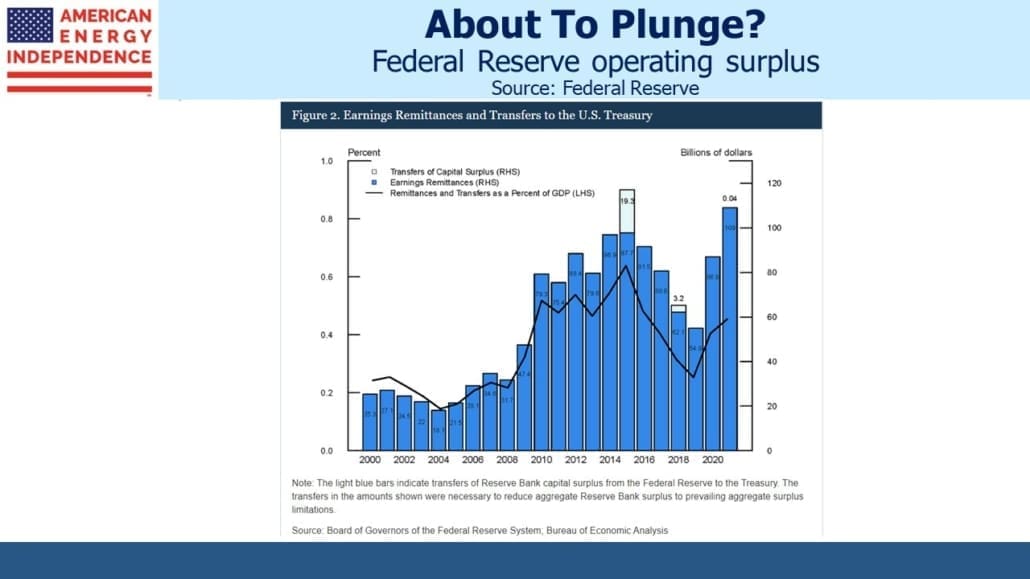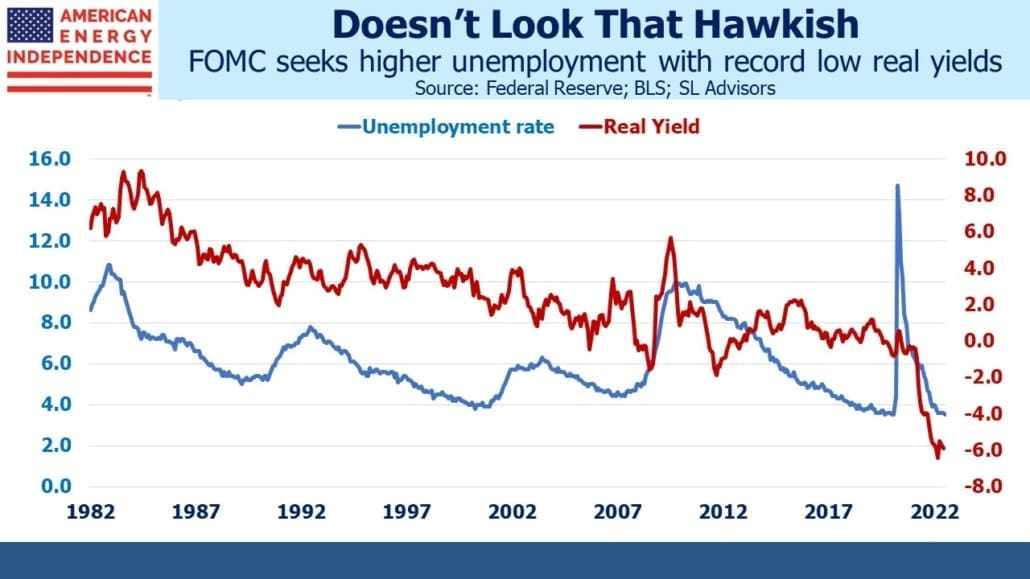The Fed’s Hobson’s Choice

/
The Fed has a problem with long-term yields. They are remaining stubbornly low, in willful defiance of steadily increasing short term rates. Slowing the economy so as to raise unemployment will be hard unless bond yields move high enough to impede some capital investment and debt issuance. There were signs of this in the spring when rising mortgage yields caused housing to weaken. But ten year notes soon fell back below 3%.
Today’s real yield (defined as the ten year notes minus one year trailing CPI) is –6%. Since the inflation peak of the early 1980s, slowing the economy and increasing unemployment has almost always required positive real rates. We’re not close.
Friday’s payroll report was surprisingly strong. Everybody who wants a job has one. The FOMC’s Summary of Economic Projections warns that the Fed funds rate will reach 3.8% by the end of next year. Bond investors are unfazed by this – eurodollar futures are priced for a more sanguine 3.25%, and were even more relaxed prior to Friday’s strong data. But in either scenario, the yield curve will remain inverted.
The Fed’s goal is to drive up unemployment. Their public comments rely heavily on euphemisms because it’s a heartless goal. Inflation is the scourge that harms all, so some of you will be sacrificed (ie lose your jobs) for the greater good. It’s monetary orthodoxy traditionally supported by Republicans, but there is much that could go wrong.
Given employment’s apparent resilience in response to the FOMC’s early moves, it’s possible that short term rates will need to move higher than 3.8%. Ten year treasury yields may need to reach 4% in order to add a few million unemployed, which would presumably require the Fed funds rate to reach at least 5%.
Fed chair Jay Powell will refer to the resulting budgetary problem as merely optical, but Congress may deem it more tangible. The Fed’s $8TN balance sheet has been the world’s biggest positive carry trade, allowing them to remit a $109BN operating surplus to the Treasury last year. By paying close to zero on bank reserves, most of the coupon income from the Fed’s holdings of treasuries and Mortgage Backed Securities (MBS) funded their surplus. The Federal government’s need to fund its budget deficit was lower by this amount.
Last year the Fed’s balance sheet averaged $8.06TN. They reported $126BN in interest income, so earned around 1.5% on their holdings. Maturing short term securities this year may have pushed up the average yield on the remaining portfolio slightly, but with Fed funds at 2.25-2.5% it’s likely they’re now enduring negative carry. The operating surplus will disappear, and on present trends become a deficit by next year.
The Fed shows no inclination to sell anything. Auctioning off treasuries would be tricky because they’d have to co-ordinate with the Treasury’s own auction schedule. But selling MBS would cause the rise in bond yields they need while also reducing their negative carry. However, sales would probably result in realized losses on bonds bought at higher prices. In any event, passive balance sheet reduction is their choice, which means the 2023 operating deficit will be the first one to draw Congressional attention.
Quantitative Easing (QE) followed by its proper inverse, Quantitative Tightening (QT) with selling, means buy high and sell low. Not selling simply swaps realized losses for protracted negative carry. The Fed has implemented it on a scale likely to discredit the strategy as the bill comes due. They only implement QE during a recession, when bond prices are high/yields low.
Restraining the economic rebound QE helped cause will create an operating deficit.
The difficulty in pushing up bond yields, which creates a need for even higher short-term rates, looks like a slowly developing PR disaster for the Fed. But there’s an alternative, plausible outcome. They could point to still modest long term inflation expectations in both the market for Treasury Inflation Protected Securities (TIPs) and the University of Michigan surveys. They could sidestep the struggle to push up bond yields and slow the economy. They could “declare victory and get out”, as Senator George Aiken suggested in 1966 when discussing Vietnam. The Fed could at any time look beyond the latest CPI release and declare inflation to be on a steady path lower – which based on market indicators and surveys, it is. Under such circumstances, the politics of requiring taxpayers to fund their operating deficit would be theoretical.
These two radically different paths imply substantially different rate outcomes. It’s why bonds are so volatile nowadays. Of the two, we lean towards the latter, which avoids a recession and will allow inflation to persist at 3% or higher rather than 2%. But the FOMC’s hawkish posture shows that’s not in their current thinking. Bonds still don’t offer an investment return, but at least there are some fascinating trading opportunities.
We have three funds that seek to profit from this environment:
Please see important Legal Disclosures.

Important Disclosures
The information provided is for informational purposes only and investors should determine for themselves whether a particular service, security or product is suitable for their investment needs. The information contained herein is not complete, may not be current, is subject to change, and is subject to, and qualified in its entirety by, the more complete disclosures, risk factors and other terms that are contained in the disclosure, prospectus, and offering. Certain information herein has been obtained from third party sources and, although believed to be reliable, has not been independently verified and its accuracy or completeness cannot be guaranteed. No representation is made with respect to the accuracy, completeness or timeliness of this information. Nothing provided on this site constitutes tax advice. Individuals should seek the advice of their own tax advisor for specific information regarding tax consequences of investments. Investments in securities entail risk and are not suitable for all investors. This site is not a recommendation nor an offer to sell (or solicitation of an offer to buy) securities in the United States or in any other jurisdiction.
References to indexes and benchmarks are hypothetical illustrations of aggregate returns and do not reflect the performance of any actual investment. Investors cannot invest in an index and do not reflect the deduction of the advisor’s fees or other trading expenses. There can be no assurance that current investments will be profitable. Actual realized returns will depend on, among other factors, the value of assets and market conditions at the time of disposition, any related transaction costs, and the timing of the purchase. Indexes and benchmarks may not directly correlate or only partially relate to portfolios managed by SL Advisors as they have different underlying investments and may use different strategies or have different objectives than portfolios managed by SL Advisors (e.g. The Alerian index is a group MLP securities in the oil and gas industries. Portfolios may not include the same investments that are included in the Alerian Index. The S & P Index does not directly relate to investment strategies managed by SL Advisers.)
This site may contain forward-looking statements relating to the objectives, opportunities, and the future performance of the U.S. market generally. Forward-looking statements may be identified by the use of such words as; “believe,” “expect,” “anticipate,” “should,” “planned,” “estimated,” “potential” and other similar terms. Examples of forward-looking statements include, but are not limited to, estimates with respect to financial condition, results of operations, and success or lack of success of any particular investment strategy. All are subject to various factors, including, but not limited to general and local economic conditions, changing levels of competition within certain industries and markets, changes in interest rates, changes in legislation or regulation, and other economic, competitive, governmental, regulatory and technological factors affecting a portfolio’s operations that could cause actual results to differ materially from projected results. Such statements are forward-looking in nature and involves a number of known and unknown risks, uncertainties and other factors, and accordingly, actual results may differ materially from those reflected or contemplated in such forward-looking statements. Prospective investors are cautioned not to place undue reliance on any forward-looking statements or examples. None of SL Advisors LLC or any of its affiliates or principals nor any other individual or entity assumes any obligation to update any forward-looking statements as a result of new information, subsequent events or any other circumstances. All statements made herein speak only as of the date that they were made. r
Certain hyperlinks or referenced websites on the Site, if any, are for your convenience and forward you to third parties’ websites, which generally are recognized by their top level domain name. Any descriptions of, references to, or links to other products, publications or services does not constitute an endorsement, authorization, sponsorship by or affiliation with SL Advisors LLC with respect to any linked site or its sponsor, unless expressly stated by SL Advisors LLC. Any such information, products or sites have not necessarily been reviewed by SL Advisors LLC and are provided or maintained by third parties over whom SL Advisors LLC exercise no control. SL Advisors LLC expressly disclaim any responsibility for the content, the accuracy of the information, and/or quality of products or services provided by or advertised on these third-party sites.
All investment strategies have the potential for profit or loss. Different types of investments involve varying degrees of risk, and there can be no assurance that any specific investment will be suitable or profitable for a client’s investment portfolio.
Past performance of the American Energy Independence Index is not indicative of future returns.




It feels like whatever they have done with raising rates will be a blip compared to having to shrink their balance sheet (QT) by $x/month. Is $X = $100 billion, then they can do that for 40 months to half the Fed balance sheet? I can’t see that playing out well with liquidity, but until they do – i don’t see things returning to normal. Also, the 528k jobs number from last week was ‘seasonally adjusted’, I think the real number was -300k (yes, negative). Maybe using their standard ‘seasonal adjustment process’ during the covid recovery isn’t the right call. Keep up the good work on the long pipeline portfolio.